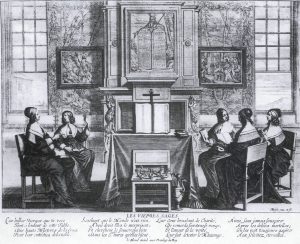
In 1595 it was announced that women are not human beings; and proof of the matter was demonstrated more than scrupulously: fifty times in succession in one and the same treatise. If women are not human then they cannot be redeemed by Jesus, who is the redeemer of human beings, went the argument. A writer familiar with the university disputation genre applied Classical Aristotelian logic to biblical maxims. Rational argumentation based on tenets of the faith led to the confident conclusion: the woman is not a human being.
The proof was published in 1595, in a treatise titled Disputatio nova contra mulieres, qua probatur eas Homines non esse (A new disputation against women, in which it is demonstrated that they are not human beings). There was no author’s name or place of printing on the title page. A fictitious date was cited to throw the reader off the scent. The treatise, which was actually published in the Lutheran setting of Leipzig, would of course have been considered impious and would never have received a seal of approval from the authorities allowing it to be printed. Once published, however, the subject aroused some degree of interest and the identity of the author – presumed to be a man – was a matter of speculation. When the moment of truth arrived and the authorities demanded to be informed of the genesis of the treatise, the publisher, Heinrich Osthaus, named a highly-regarded young humanist scholar Valens Acidalius (1567-1595) as the author. Acidalius flatly denied that he had written the tract, and he died shortly afterwards. There is much to suggest that he had actually copied the text from a manuscript already in circulation, and then given it – destined to be a bestseller – to the publisher who had previously suffered financial loss from publishing one of his learned treatises.
The tract was in fact a Lutheran discussion paper aimed at the Socinian Anabaptist sect. However flattering it might have seemed for women to be the topic of debate, they were actually the subject of this deeply ironic book in name alone. Their role was to throw light on a different matter:
Anabaptist denial of the divinity of Christ. This is implicit from the introduction:
“Since in Sarmatia, which is a land where anything goes, people are allowed to believe and teach that, together with the Holy Spirit, Jesus Christ, the Son of God, saviour and redeemer of our souls, is not God, I believe I may also freely believe and teach something much less serious – namely, that women are not fully human and what follows as a consequence: that Christ did not suffer for them and that they will not be saved.”
Whatever the original context of the treatise, it nonetheless found a firm place in the European debate on the position of women. A rejoinder appeared in the very same year it was published, similarly written in Latin and in an academic style: Simon Gediccus’ Defensio sexus muliebris (Defence of the Female Sex). For nearly two hundred years, the two treatises went on to be printed or reprinted and translated, separately or together, in numerous editions. They were first published in Danish in 1920, translated by chief librarian Sofus Larsen. Around the mid-seventeenth century they were an ingredient of every good North European academic’s general knowledge. The double-treatise Acidalius-Gediccus was, for example, reprinted in The Hague in 1638, 1641, and 1644, in Paris in 1693, in Amsterdam in 1744, and in Paris 1766. It kept the feminist/anti-feminist debate going for one and a half centuries.
An illustration of the mode of argumentation applied in Acidalius’ treatise on women is here found in section 9 on “causa efficiens” (the efficient cause) and “causa instrumentalis” (the instrumental cause):
“Common experience shows us, and it is the agreed opinion of all people who think in a philosophical [way], that in all natural matters nothing can be done where these two causes, efficient and instrumental, are not found together. A smith cannot forge a sword without the help of a hammer; in the same way a scribe cannot write without the help of a pen; a tailor cannot sew without the help of a needle; a man cannot beget offspring without the help of a woman. Now, just as the hammer is not the smith, the needle is not the tailor, the pen is not the scribe, so the woman is not the man. If anyone denies that the woman is the instrumental cause, let him suggest to us another; if he points to the privy members, saying that it is they, he will be laughed at by all. For an instrument is never a natural born part of the efficient agent, but is separate from it […].”
Vives: “Instruction of a Christian Woman” (1523)
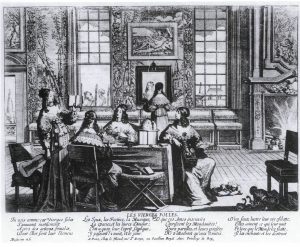
The Valens Acidalius / Simon Gediccus debate was far from unique. The number and quality of treatises discussing women’s talents or lack thereof was high. We know that the works mentioned were known in the Nordic region, but they are only examples of the material in circulation.
The Europe of this period read an entire corpus of literature on the subject of women. The works were divided up by genre and were available in both printed and handwritten form. It is an established fact that readers in the Nordic countries were familiar with European concepts such as “Feminae illustres” (illustrious women), “Feminae doctae” (learned women), “Musa decimal” (the tenth muse), and so forth. The following section will look at a selection of writings that took a positive stance on women’s abilities and their right to use them: works that not only contributed to a change of attitude as regards female artists and writers generally, but were also a motivational force for many women.
A genre that undoubtedly affected the view of women, and women’s own view of their opportunities in life, whether they had read this kind of book or had simply heard about it from others who had, was that of the pedagogical treatise. Upbringing and education were, of course, mainly undertaken via the spoken word. It is also clear that the most pioneering and innovative educational writings produced in the age of humanism were addressed to boys and men – preferably princes. The theorists circulated their new ideas around Europe, in Latin; these ideas were read and discussed and, at best, helped shape a new era for any given state. The future ruler’s attitude towards his fellow human beings was going to be of crucial importance to the way in which he dealt with issues of high politics.
Such interests played no role in matters of girls’ upbringing. As women had no access to any kind of public office, there was a limit to how much havoc they could wreak if they broke unwritten laws. On the other hand, women and children had to be kept in check, and did not always live according to the precepts laid down for them. It could therefore be pragmatic to keep them in line with a set of general rules, so that the family could be a credit to God and king, and life could run as smoothly as possible for everyone else. To that end, quite a few books were written about what young girls and women might and should do, and what they were not allowed to do. These books were most often written in the national language, and could include anything from lists of standard acceptable modes of conduct to carefully thought-out moral philosophy reflecting an independent attitude to life.
One of the categorically most interesting works in this context was written by the Spanish humanist Juan Luis Vives; three sections on the conduct of a Christian woman: De institutione feminae Christianae (The Instruction of a Christian Woman), published in 1523. The work was dedicated to the English Queen Catherine of Aragon, one of the Spanish King Ferdinand II’s four daughters. It was reprinted more than ten times during the sixteenth century and translated into various languages, including French, German and Danish.
It is rare to find proof of an up-to-the-minute European text being known by women in the Nordic region during the seventeenth century.
Vives’ treatise is one of the few exceptions. A noblewoman called Susanne Giøe translated part of it into Danish in 1659. The first of the three sections, which she called “Om Jomfruers Optuctelse” (On the Instruction of Maidens), interested her, whereas she omitted the second section, about the married woman, and the third section, about the widow. The translation, which has never been published, was prepared on the basis of a French version of the text. Susanne Giøe was unlikely to have understood Latin.
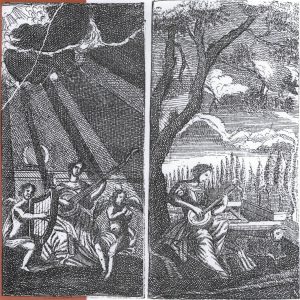
“The Instruction of a Christian Woman” is anything but a revolutionary treatise. Vives keeps women to their housework, prayers, children and virtue. He goes methodically to work within the traditional areas affecting women’s everyday lives and their relationship to men. The treatise is thus an interesting source of information regarding ideas about women that were current at the time. Vives presumably imagines that his readership will be male; by writing in Latin he is addressing the intellectual world which transcended national frontiers.
Vives, who lived from 1492 until 1540, knew Erasmus of Rotterdam and Thomas More. He studied at European universities, and spent a considerable amount of time in England in his young days. He penned a long list of writings; women’s topics were by no means his only area of interest. His work spans a broad spectrum of traditional humanist subjects, covering the writers of antiquity, Christian theology, language and grammar, moral philosophy and letter writing. The philosophy of education – including the education of women – fell within the humanists’ sphere of interest, and Vives’ tract on the duties of the husband, De officio mariti, and particularly his writing about the education of princes, De institutione principis, were among his read and well-known works.
Like the bachelor Erasmus, the unmarried Vives also weighed up his colleague More’s pedagogical experiments on the home front. More’s daughters were given lessons in languages and literature and were known for their scholarship. In their lifetime they were walking proof that women could assimilate complex ideas, neither suffering damage in so doing nor becoming a danger to society on account of their knowledge. Influenced by this happy example, both Vives and Erasmus came to the conclusion – one which had already been reached by a number of the earliest Italian humanists – that it might be advantageous for certain women, those who clearly showed a talent for learning, if they were allowed to pursue their intellectual interests. Some parameters would of course be necessary, and Vives was not one to advocate permission for women to study, for example, medicine and anatomy.
In the first three chapters of his De institutione feminae Christianae (The Instruction of a Christian Woman), Vives looks at the girl’s infancy and early childhood. He states his opinion, which he knows far from everyone shares, that mothers should nurse their children themselves. In the section on the upbringing of ‘maidens’, he describes vice as being a threat to the teenage girl. The girl might be tempted, and she could easily be led to believe that something is desirable when it is in fact a vice. Vives discusses how to arm the girl against vice, and he reaches the conclusion that education would be a help.
Vives includes this minority of promising women in his treatise on the education of Christian women. Although he was only concerned with affluent women – and however small he might have thought the group showing any degree of intelligence – it was of crucial significance that he mentioned them at all. He had no need to refer to such a group in his genre of pedagogical treatise. The contents list in the work discloses nothing unexpected, with the exception of the chapter on learning. This is in the first section, on the ‘maidens’, chapter 4. ‘How to avoid vice?’ he asks. And answers: ‘through reading and education’. He then addresses hypothetical protests such as: ‘but it is far better to set rules for what is correct conduct than to state what is not allowed.’ The latter might give the girls bad ideas. ‘Rules as to what is correct,’ he responds, ‘can be all very well in ordinary circumstances, but it is better to have knowledge of what is right and wrong when in an unforeseen situation.’ And unforeseen situations will indeed occur. Girls ought thus to receive more education than was the norm. Not that they should receive as much as boys, for boys must be very well informed so that they can later act independently to the benefit of the community, which is to say, society at large. Adult women, on the other hand, shall remain at home, and if they are out they shall remain silent, as prescribed by Saint Paul. However, they must be able to act to the benefit of themselves and, to a certain extent, to that of their husbands. They must also be able to occupy themselves once they have completed the housework and their prayers. Studies and reading are useful for this purpose.
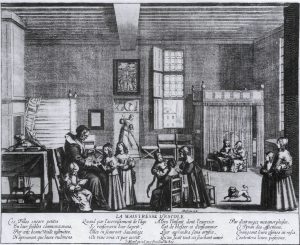
Deliberations of this kind lead Vives to the conclusion that academic education has, all in all, a good rather than a bad influence on girls, and he spends a whole chapter discussing which authors should be read and which should not, “Qui non legendi scriptores, qui legendi”. Vives begins by pointing out how much bad literature is available to people who have time on their hands – which is, in itself, suspect. In particular, he finds it strange that some fathers allow their daughters to read fiction about war and love, or that husbands allow their wives to do so. He wonders why the preachers, who make such a fuss about so many other matters, do not speak out against this in every sermon.
Bad literature should be taken away from women in the same way as serpents and snakes would be removed from them, instructs Vives. The books must be confiscated for a period or, if there is a relapse later on, for ever.
Antiquity has little to offer in the way of recommended reading for women. It is teeming with immoral females who do what they want, who cheat and deceive, who live a life of luxury that should not even be mentioned to a Christian virgin, who meddle in politics and financial affairs, and so forth. To find decent, edifying literature one must turn to the Christian Middle Ages. Best of all, of course, is the Bible. Vives’ list of literature recommended for women therefore includes, not particularly surprisingly: the Gospels, the Acts of the Apostles, the historical and moral books of the Old Testament, Cyprian, Hieronymus, Augustine, Ambrose, Chrysostomus, Hilary, Gregory, Boethius, Fulgentius, Tertullian, Plato, Cicero, and Seneca. The most interesting aspect of this long list is the significance the last-mentioned writer was to have for the learned women. That they were allowed to read the Bible would not really have surprised anyone, and similarly the writings of the Church Fathers and Christian commentators. At the bottom of the list we find the pagan writers of antiquity in a radically censored selection: three philosophers. Not exactly a bundle of fun. No poetry, no romance, no history, and no fiction. But it was a start – and who knows which books were actually taken down from the shelves by the woman who could go to the house library and read a book in Latin?
Not all literature from antiquity was permitted reading for women. Love poetry, for example, was out of bounds. Acceptable literature could also, however, be read from diverse vantage points. Men’s reading of the philosopher Seneca, for example, was different to that of women. The latter carefully selected the passages about women’s right to study, and used the highly-regarded classical writer in their argument for women’s access to book, pen and paper.
The Learned Women
There is no smoke without fire. Nor is there, of course, any debate about learned women without learned women. ‘Learned women’ is a vague term, which is fortunately less ‘dry’ in the centuries from the Renaissance up until the Romantic era than it might sound today. A learned woman was a women who had made herself noticed, as an individual and in her own name – or hidden behind a play of words or an abbreviation of her name, which her contemporaries knew how to unravel – by virtue of her academic knowledge and artistic or intellectual achievements such as language skills and teaching. It was rare to find a learned woman who only had one area of expertise. Knowledge of many areas was clearly admired. Every catalogue of the learned women’s talents usually includes academic and artistic achievements alike. These could, for example, be listed thus: As a child she had learnt her native tongue and quite a few other languages. At the age of fourteen she had written a poem, which she had dedicated to the king, and later she had acquired a great deal of knowledge about her family history and the history of her country. She exercised her musical talent elegantly and was known for her beautiful voice. She also painted and embroidered. There was discussion as to the necessity of being familiar with Latin and Greek in order to warrant the appellation ‘learned’. These latter skills were traditionally considered necessary, but relatively few learned women were actually in command of them.
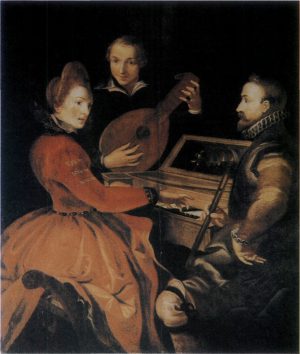
Awareness of “feminae illustres” or “feminae doctae” seems to have been linked to the Renaissance period. There were, of course, earlier examples of learned women, but the desire to count them and classify them, and even promote them, would seem to have been a Renaissance inclination that surfaced among the progressive male learned circles.
Looking at the social background of the women, we see that they typically came from affluent settings. This is what we might expect. It is in these circles that we find learned men, public officials, clergymen, politicians, doctors and so forth. They processed the academic culture through the maintenance of tradition, evaluation of innovation and their own literary invention. As early as the 1500s, however, northern European male intellectual circles experienced a social shift away from the nobility and over to the upper middle classes, whereas no similar change seems to be typical among the women. Right into the 1700s, educated women were found in greater numbers among the aristocracy than in any other social strata. This was also the only section of society in which women had a chance of daily association with books. There were libraries in their homes. A middle-class man could study at university while earning his keep as a private tutor in a nobleman’s household; there were books in both places. Women had no access to books anywhere. Public libraries did not exist, and middle-class homes could seldom afford a large book collection.
Above all, women from the nobility were the only ones who had proper relief from domestic work, although even they were far from totally exempt. They had to organise the management of the house and make decisions about both the details and the overall strategies affecting the family’s financial situation. They had to bear children and take care of their upbringing. Sickbeds and deathbeds were also heavy work and extremely time-consuming. It is surprising to see the extent to which women who did actually manage to put pen to paper accepted the terms for who was allowed to read and write. That, at least, is the impression given when they personally demanded the right to engage in studies, as can be seen in the cases of Anna Maria van Schurman in the Netherlands, and Birgitte Thott and Anne Margrethe Bredal in Denmark.
Anna Maria van Schurman,Tenth Muse of the Netherlands
“Lingvas Latinam, Graecam et Hebraeam, adeo accurarate calluit, ut elegantissime iis et scriberet, et loqueretur […].” “She mastered Latin, Greek and Hebrew so well that she could both write and speak these languages perfectly. Besides her native tongues of German and Dutch, she had, according to Lud. Jacobus – and the others who have lauded her and who normally followed this portrayal – acquired eminent knowledge of many foreign languages, including French, English, Italian and Spanish of the European tongues, and Chaldaic, Syrian, Turkish and Arabic of the Oriental languages. […] To these, moreover, should be added […] Samaritan, Persian and Ethiopian.”
This was the list of the languages that the Dutchwoman Anna Maria van Schurman (1607-1678) was thought to have mastered, according to Johannes Moller’s article about her, published in Cimbria Litterata, vol. 2, 1744. That she also had a thorough knowledge of theology and was well-versed in matters of law, philosophy, and mathematics; could play instruments and sing; and painted, made sculptures, engraved, and embroidered was known throughout most of Europe; particularly after 1636 when she became ‘world famous’, that is, known in all the intellectual European circles. As the foremost Latinist in Utrecht, she was asked by the coming principal to write an ode celebrating the opening of the new university. The poem has survived among her published poems, and in her day was apparently printed in the scholarly journals of several countries.
We can investigate her scholarship by reading, for example, her Opuscula hebraea, graeca, latina, gallica, prosaica et metrica (Little works in Hebrew, Greek, Latin and French, prose and poetry), in which she writes in the languages mentioned – although she only employs Hebrew for Bible quotations – and discusses complex theological issues, among other subjects.
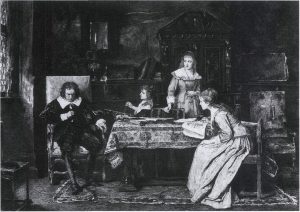
Anna Maria van Schurman is one of the really first-class exhibits in the collection of northern European learned women. She was also treated as such in her lifetime, when she was the motive and main attraction for many foreign travellers visiting the Netherlands in the mid-1600s. She received these guests in her spartan home. They asked her questions, which she answered as far as she could in the guest’s native language, often via a learned man who also monitored whether her replies were of scholarly interest. After a while she became tired of this game, as it was of less benefit to her than to the tourist, and she eventually became more reserved and rationed her audiences. Although she had admirers among the intellectual men who respected her talents, she did not wish to marry. At her father’s deathbed, she had made a vow not to ruin her life by marrying. Her father had taught her Latin, not in a classroom with threats and punishments, but by wandering between the trees in the garden with a Seneca book in his hand. There can be no doubt that he wished the best for her.
Nevertheless, academic life was not to bring her happiness. Anna Maria van Schurman threw it spontaneously overboard when she met the mesmerizing sect leader Jean de Labadie. Labadie was a deeply religious man who, having run into a brick wall with both Catholicism and the Reformed Church, took an independent path following his own interpretation of the Bible. With compelling power, and very close links to the Jesus figure of Christianity, he attracted a following wherever he preached his ideas. Quite surprisingly, Anna Maria van Schurman was one of them. She left home and followed him to Amsterdam, where she worked to establish the sect of “Labadism”. She called herself Maria (Mary) or mother; Labadie was the father in this intimate Christian community, which flourished for the next forty years despite persecution and banishments in the Netherlands. Schurman’s autobiography, Eukleria, dates to her time with the Labadists. It was written in Latin and is primarily an account of her religious life.
Schurman came to symbolise the northern European learned woman. As such, her reputation was known in Denmark and she was held up as an example by those who cared about such matters. This image was also promoted by a dissertation she published in 1638: Amica dissertatio inter noblissimam virginem Annam Mariam a Schurman et Andream Rivetum de ingenii muliebris ad scientias et meliores literas capacitate De ingenii muliebris ad studia meliora capacitate (A Friendly Discourse Between the Renowned Miss Anna Maria van Schurman and André Rivet on the Aptitude of the Female Mind for the Study of Sciences and Advanced Literature). The treatise was composed in epistolary form, and was based on her probably slightly revised actual correspondence with the Frenchman André Rivet. The title page presented it as “An amicable dispute between the most excellent maiden Anna Maria van Schurman and André Rivet”. In this exchange of letters, which comprises nearly fifty pages written in Latin, Anna Maria van Schurman defends her viewpoint: that women can most advantageously engage in intellectual pursuits. She dissociates herself from extreme feminists in southern Europe, who thought that women were more suited to study than men, and she keeps an altogether boringly respectable and modest profile in her demands. The treatise was reprinted and expanded with a thirty-page introduction in fifteen polemic syllogisms with the title Problema Practicum: Num feminæ Christianæ conveniat studium Litterarum? (A Practical Problem: Whether the Study of Letters Is Fitting for a Christian Woman). The answer is: yes. But it is a well-defined affirmative because, as mentioned earlier, the concept of ‘the Christian woman’ is given an extremely restrictive definition:
“First, in respect to the subject, it is presumed that our woman has at least a mediocre ability and is not utterly inept at learning. Second, we presume that she will be instructed by the necessary means and that the limited wealth of the household does not altogether stand in her way. […] Third, we presume that the circumstances of her time and fortune are such that it is possible sometimes to be free from any general or special calling, and certainly from the exercises of devotion or from the duties of the household. As follows easily from this, what helps is, in part, in childhood, immunity and freedom from cares and responsibilities and, in part, in a more advanced age, either celibacy or the attendance of servants who usually free wealthy women in large part from domestic duties. Fourth, the goal of studies is presumed not to be vainglory and show or idle curiosity, but rather the general goal of the glory of God and the salvation of one’s soul in order that she may also emerge the better and happier, and may educate and guide her family (if that duty falls to her) and even be useful to her whole sex, to the extent that that is possible.”
Perhaps it was precisely because of her moderate feminism that Anna Maria van Schurman achieved the ‘idol’ status she obviously enjoyed among women and progressive men alike in the mid-seventeenth-century Nordic region. She was so talented that she just had to be an exception, a woman who rose above her gender, “supra sexum”, as was said. She was thus a woman who could make men ashamed when seeing themselves outdone by a miracle, but never a woman they compared with their wives. She was therefore never a real threat to men’s privileges. A few men observed Schurman and the other learned women in the light of actual mortal women; they saw their shackles, encouraged the women to study despite motherhood and domestic duties, pointed out their great talents, and gave them moral support so that they, like normal people, could both have babies and books in their lives. Men such as these were the authors of “gynaecea”.
Translated by Gaye Kynoch

